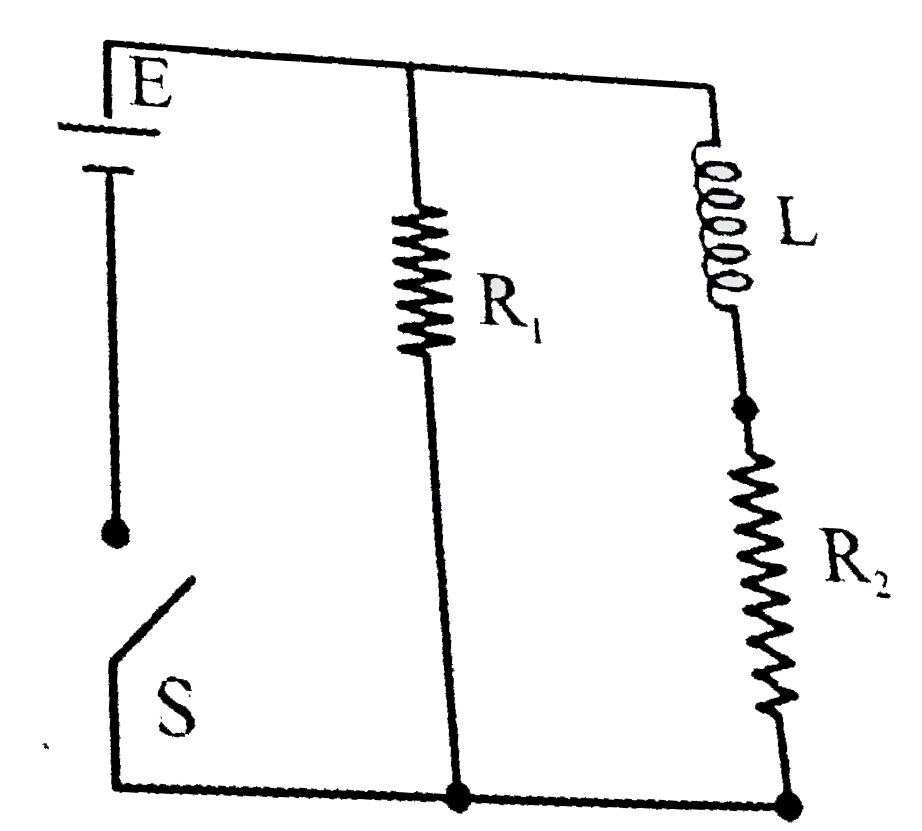An inductor of reactance XL=4Ω and resistor of resistance R=3Ω are connected in series with a voltage source of emf ε=(20V)[sin(100π(rads))t]. The current in the circuit at any time t will be
I=(4A)[sin(100π(rads))t+37°]
I=(4A)[sin(100π(rads))t−37°]
I=(4A)[sin(100π(rads))t+53°]
I=(4A)[sin(100π(rads))t−53°]
To solve the problem, we will follow these steps:
Step 1: Calculate the Impedance (Z)
The impedance in a series circuit with a resistor (R) and an inductor (XL) is given by the formula:
Z=√R2+X2L
Given:
- R=3Ω
- XL=4Ω
Substituting the values:
Z=√32+42=√9+16=√25=5Ω
Step 2: Calculate the Maximum Current (I_max)
The maximum current in the circuit can be calculated using the formula:
Imax=VmaxZ
Given:
- Vmax=20V
Substituting the values:
Imax=205=4A
Step 3: Determine the Phase Angle (θ)
The phase angle (θ) between the voltage and the current in an R-L circuit can be calculated using:
tan(θ)=XLR
Substituting the values:
tan(θ)=43
To find θ, we take the arctangent:
θ=tan−1(43)
Calculating θ:
θ≈53∘
Step 4: Write the Current Equation
The current in the circuit can be expressed as:
I(t)=Imaxsin(ωt−θ)
Where:
- ω=100πrad/s
- Imax=4A
- θ≈53∘
Substituting the values:
I(t)=4sin(100πt−53∘)
Final Answer
Thus, the current in the circuit at any time t is:
I(t)=4sin(100πt−53∘)
---
The impedance in a series circuit with a resistor (R) and an inductor (XL) is given by the formula:
Z=√R2+X2L
- R=3Ω
- XL=4Ω
Z=√32+42=√9+16=√25=5Ω
The maximum current in the circuit can be calculated using the formula:
Imax=VmaxZ
- Vmax=20V
Imax=205=4A
The phase angle (θ) between the voltage and the current in an R-L circuit can be calculated using:
tan(θ)=XLR
tan(θ)=43
θ=tan−1(43)
θ≈53∘
The current in the circuit can be expressed as:
I(t)=Imaxsin(ωt−θ)
- ω=100πrad/s
- Imax=4A
- θ≈53∘
I(t)=4sin(100πt−53∘)
Thus, the current in the circuit at any time t is:
I(t)=4sin(100πt−53∘)
Similar Questions
A capacitor of capacitance 2 mF and resistor of resistance 12 Ω are connected in series with voltage source V=(195√2(V))[sin(100rads)t] - The average power dissipated in the circuit will be
View SolutionAn inductor of inductance L = 8 H and a resistor of resistance R = 2Ω are connected in series with a battery of emf E = 10 V as shown in the figure. If the switch is closed at t = 0, then the voltage drop across the inductor at t = 1 s will be in volts)
View SolutionA 6 V, 12 W lamp is connected in series with a resistor R and a source of voltage 12 V.
What is the current flowing through the circuit?
View SolutionAn inductor of inductance L = 400 mH and resistors of resistance R1=2Ω and R2=2Ω are connected to a battery of emf 12 V as shown in the figure. The internal resistance of the battery is negligible. The switch S is closed at t=0. The potential drop across L as a function of time is

View SolutionAn inductor of inductance L = 400 mH and resistors of resistance R1=2Ω and R2=2Ω are connected to a battery of emf 12 V as shown in the figure. The internal resistance of the battery is negligible. The switch S is closed at t=0. The potential drop across L as a function of time is

View SolutionAn inductor of inductance L = 400 mH and resistors of resistance R1=2Ω and R2=2Ω are connected to a battery of emf 12 V as shown in the figure. The internal resistance of the battery is negligible. The switch S is closed at t=0. The potential drop across L as a function of time is

View SolutionA 10 muF capacitor, an inductor and a resistor of 100Omega are connected to an alternating source of emf 200sqrt2 sin 100t as shown in the figure. What is the r.m.s current in the circuit and the value of the inductance if the current and the source voltage attain their maxima simultaneously? What is the average power consumed in this case

View SolutionAn inductor 20×10−3 a capacitor 100(μ)F and a resistor 50Ω are connected in series across a source of emf V=10sin314t.
Then the energy dissipated in the circuit in 20 mim is
View SolutionAn inductor 20×10−3 a capacitor 100(μ)F and a resistor 50Ω are connected in series across a source of emf V=10sin314t.
If resistance is removed from the circuit and the value of inductance is doubled, the variation of current with time in the new circuit is
View SolutionA satellite is launched into a circular orbit of radius R around the earth while a second satellite is launched into an orbit of radius 1.02R. The percentage difference in the time period is:
View Solution
